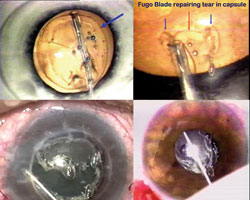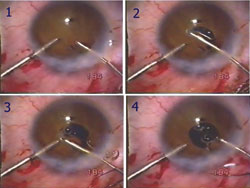Plasma blade has several applications in ophthalmic surgery
The blade is approved for use in capsulotomy, iridotomy and transciliary filtration procedures.
 Thomas John |
Ophthalmic surgical incisions can be made using various methods, including mechanical blades made of steel, diamond or sapphire; radiofrequency; diathermy; and lasers. More recently, gamma knife radiosurgery has been used to treat intraocular tumors. The “blades” of the gamma knife are beams of gamma radiation programmed to target the unwanted lesion.
Unlike the sharp edge of a metal blade or an electrosurgical cutter, a plasma blade uses pulses of plasma that are generated around its tip to cut and cauterize tissue without any extensive collateral tissue damage. Added benefits of a plasma blade include improved wound healing, reduced thermal injury to adjacent tissue and no excessive bleeding.
In this column, Dr. Richard J. Fugo describes the use of the plasma blade in ophthalmic surgery.
– Thomas John, MD
OSN Surgical Maneuvers
Editor
 Richard J. Fugo |
The plasma blade, also known as the Fugo blade, is the first plasma ablation system that can create precise low-energy incisions on the ocular surface and within the human eye. The U.S. Food and Drug Administration has approved this plasma blade for capsulotomy, iridotomy and transciliary filtration.
Plasma blade
The Fugo plasma blade is a portable, battery-powered, solid-state system (Medisurg Research & Management) that uses C-cell batteries. It conditions the energy in a portable, solid-state console and then focuses the energy on a blunt hair-thin ablation/cutting filament. This energy field produces a controllable and visible plasma column. Histologic studies at the University of South Carolina and Louisiana State University on the incision walls created by this plasma blade have demonstrated pristine, clean incision walls based on nanotechnology stripping of tissue molecules, thereby eliminating the charring or incision wall damage seen in most other standard electrosurgical systems. Additionally, it produces a non-cauterizing hemostasis and kills any microbes in the incision path.
Capsulotomy
Plasma blade capsulotomy for cataract surgery was first approved by the FDA in 2000, and it has provided a unique ability to manage difficult cases, as well as an ability to surgically manage capsular tears (Figure 1). The resistance-free ablation is invaluable in cases with weak zonules, dense membranes or small pupils such as in intraoperative floppy iris syndrome. A plasma blade capsulotomy can be performed beneath a penetrating keratoplasty graft, and no postoperative graft decompensation has been reported in more than 10 years with such graft-associated capsulotomies.
 Figure 1. Top left: A round plasma blade capsulotomy is performed just inside the pupillary margin (blue arrow) within seconds. Top right: A horizontal capsular tear is visible (red arrow). Two perpendicular vertical plasma blade ablation lines are created on either side of the horizontal tear (blue arrows). This prevents any peripheral extension of the capsular tear. The ablation paths on either side have rounded edges (no acute angles), and hence these ablation paths cannot continue to tear or run. Bottom left: A plasma blade capsulotomy is performed beneath a clear penetrating keratoplasty graft. Bottom right: A large capsulotomy is performed beneath the iris in an intraoperative floppy iris syndrome case, with no direct visualization of the capsulotomy tip. Images: Fugo RJ |
Patients with intraoperative floppy iris syndrome can easily be managed by placing the ablation filament tip under the iris (out of view of the surgeon) and slowly ablating a 360° capsulotomy, after which the nucleus is impaled and pulled into the pupil with the phaco tip, while the surgeon’s second hand is injecting viscoelastic material behind the nucleus. Thus, the posterior capsule is pushed back, and the nucleus is held up at the iris plane by the injected viscoelastic material. The nucleus is then cracked and phacoemulsified. Thus, the nucleus acts like a pupil expander because it holds the pupil open. I go beneath the iris with the capsulotomy tip in more than 40% of my cases.
Iridotomy and pupilloplasty
Iridotomy is performed by placing the ablation tip at the intended site of iridotomy, and the tip is activated for a second or two, thereby creating a bloodless iridotomy. The size of the iridotomy is under surgeon control. Such an iridotomy can be placed far out in the periphery adjacent to the iris root and can be useful in Visian implantable Collamer lens (STAAR Surgical) surgery. The plasma blade is also useful in performing pupilloplasty (Figure 2).
 Figure 2. Tracing the blunt plasma blade probe over the iris in this bound-down pupil in a counterclockwise circle creates a cosmetically perfect bloodless pupil. |
 Figure 3. Transciliary filtration requires a precise plasma ostomy created by plasma ablation into the posterior chamber and rarely produces a postoperative flat anterior chamber. |
Transciliary filtration
Transciliary filtration (TCF) or Singh filtration — Dr. Daljit Singh in India first described TCF — drains aqueous from behind the iris, ie, from the posterior chamber (Figure 3). This is the first FDA-approved retro-iris filtration procedure.
TCF may be considered to change the paradigm of filtering surgery. In more than 5,000 cases worldwide, there has been only one reported case of a flat anterior chamber. By filtering aqueous from the posterior chamber, the force vectors pushing against the back surface of the iris are reduced lower than the force vectors pushing against the front surface of the iris. Therefore, the force vectors pushing the iris forward are always lower than the force vectors pushing the iris backward, making it near impossible for the iris to flatten against the cornea. In my 8 years of experience with TCF, I have yet to see a single flat anterior chamber postoperatively.
After a simple conjunctival flap, a 30-second transillumination of the anterior chamber with the surgical microscope allows the exact location to plasma-ablate into the posterior chamber of the eye. Aqueous flow from the ablation pore is thought to be auto-regulated as the flaccid finger processes of the pars plicata are presumed to temporarily herniate into the filtration pore as the eye softens and are then presumed to pull out of the pore as the IOP begins to increase and the finger processes become rigid and tense. Theoretically, this auto-regulatory cycle is believed to repeat as the IOP increases and decreases. A watertight seal is not needed, and hence, only two or three conjunctival sutures are placed at the limbus.
The TCF procedure can be performed under topical anesthesia. A 1-minute exposure of mitomycin C is often useful. A recent approach has been the combination of plasma ablation trabeculectomy and TCF, with early promising results as per Dr. Amar Atwal, of Buffalo, N.Y.
References:
- Fugo RJ, DelCampo DM. The Fugo Blade: the next step after capsulorhexis. Ann Ophthalmol. 2001;33(1):12-20.
- Peponis V, Rosenberg P, Reddy SV, Herz JB, Kaufman HE. The use of the Fugo Blade in corneal surgery: a preliminary animal study. Cornea. 2006;25(2):206-208.
- Trivedi RH, Wilson ME Jr, Bartholomew LR. Extensibility and scanning electron microscopy evaluation of 5 pediatric anterior capsulotomy techniques in a porcine model. J Cataract Refract Surg. 2006;32(7):1206-1213.
- Singh D, Singh K. Transciliary filtration using the Fugo Blade. Ann Ophthalmol. 2002;34(3):183-187.
- Thomas John, MD, is a clinical associate professor at Loyola University at Chicago and is in private practice in Tinley Park and Oak Lawn, Ill. He can be reached at 708-429-2223; fax: 708-429-2226; e-mail: tjcornea@gmail.com.
- Richard J. Fugo, MD, PhD, can be reached at the Medisurg Research & Management, 100 W. Fornance St., Norristown, PA 19401; 610-279-5550; e-mail: medisurgltd@yahoo.com. Dr. Fugo has a direct financial interest in the Fugo Blade and is a stockholder in Medisurg.

